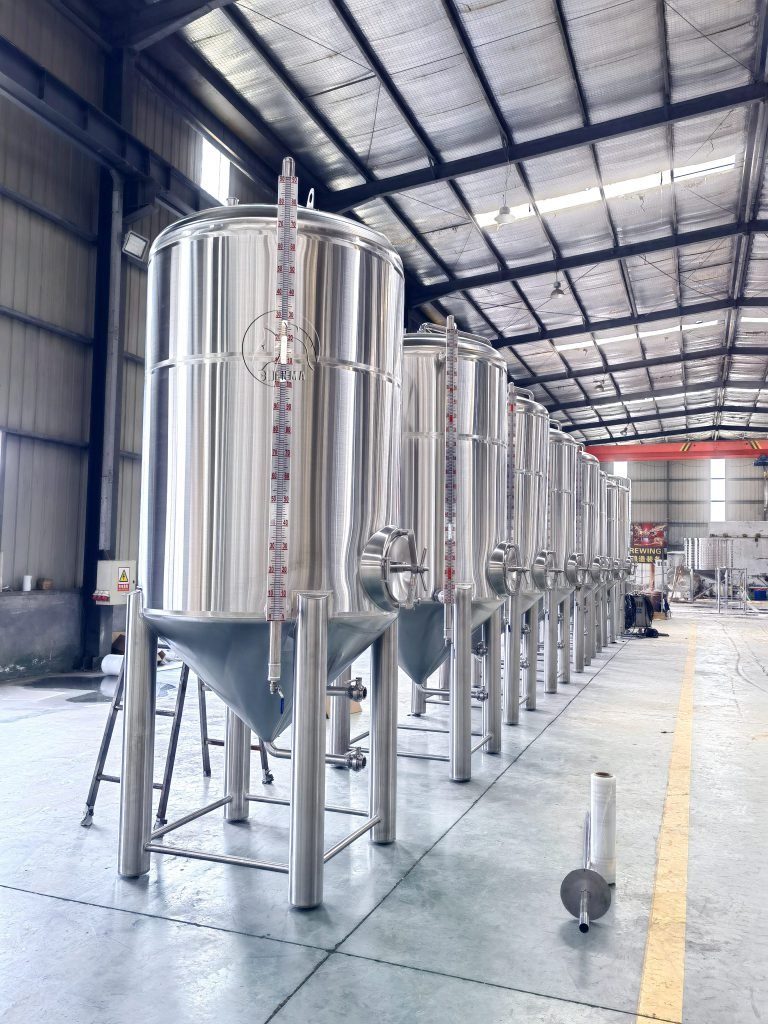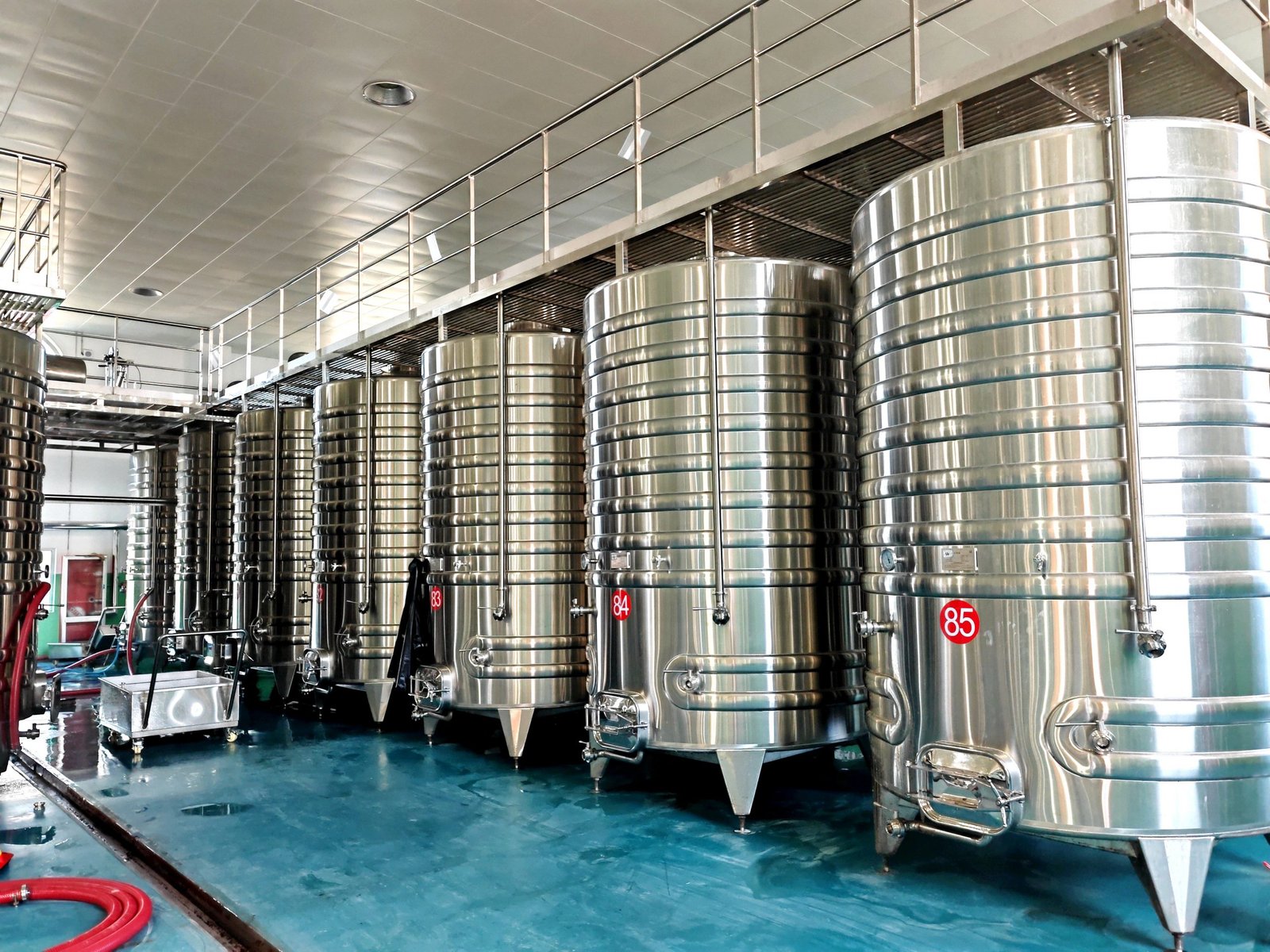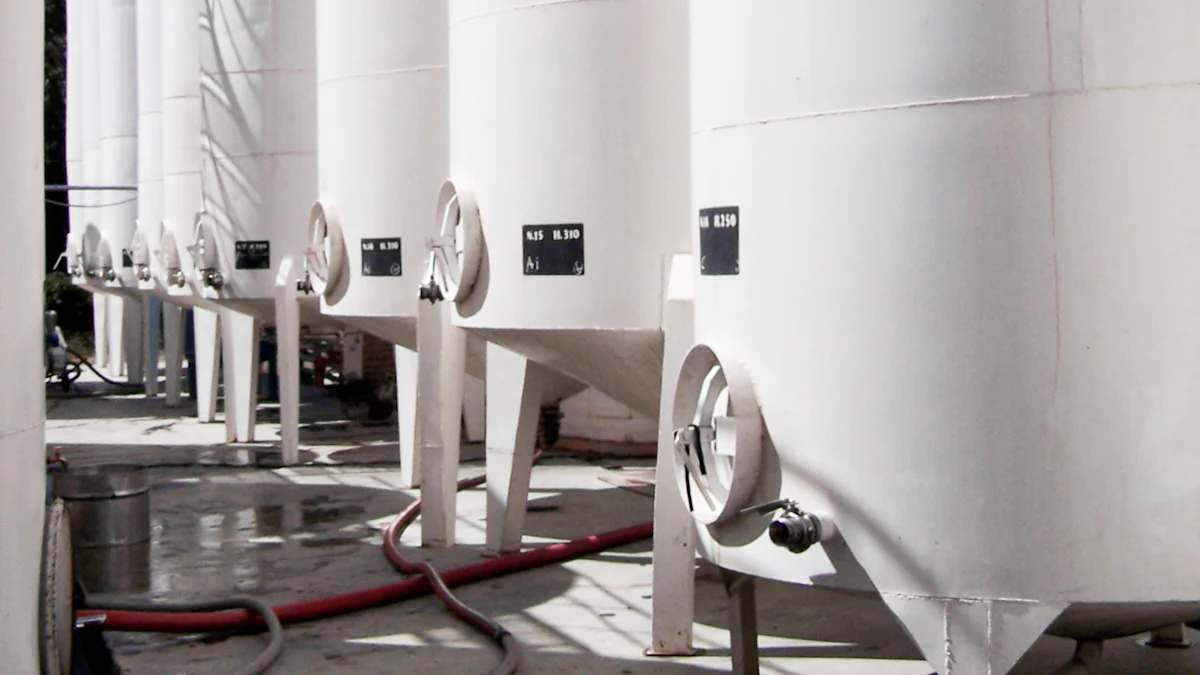
Proper maintenance of your stainless steel oil tank is essential for ensuring safety, efficiency, and durability. Regular upkeep can significantly extend its lifespan, with well-maintained tanks lasting 20-30 years or more. Neglecting maintenance, however, often leads to costly repairs or premature tank failure. Common risks, such as oil leaks or sludge buildup, not only reduce efficiency but also pose serious safety concerns. By following practical maintenance tips, you can prevent these issues and keep your tank in optimal condition. A proactive approach safeguards your investment and ensures long-term reliability.
Chenma is one of the professional stainless steel mixing tank manufacturers that can provide various stain steel tank solutions.
Importance of Stainless Steel Oil Tank Maintenance
Why Regular Maintenance Matters
Regular maintenance plays a vital role in preserving the integrity of your stainless steel oil tank. Without it, small issues can quickly escalate into costly problems. For example, regular inspections help you identify potential leaks or structural weaknesses early, preventing expensive repairs or even full tank replacements. Maintenance also ensures your tank operates efficiently, which reduces fuel consumption and saves money over time.
Neglecting maintenance can lead to serious consequences. Leaks and spills may contaminate soil and water, creating environmental and safety hazards. Additionally, failing to maintain your tank could result in regulatory non-compliance, leading to fines or penalties. By following best practices, you not only protect your investment but also avoid unnecessary risks.
Benefits of a Well-Maintained Tank
A well-maintained stainless steel oil tank offers numerous financial and operational benefits. First, it extends the lifespan of your tank, reducing the need for frequent replacements. This long-term durability saves you money and ensures your tank remains reliable for years. Second, regular maintenance keeps your tank running smoothly, which helps your heating system use less fuel and operate more efficiently.
Another key benefit is the prevention of costly repairs. By addressing minor issues early, you avoid major problems that could disrupt your operations. Proper maintenance also helps you stay compliant with regulatory inspections, ensuring you avoid fines or penalties. Insurance claims for damages are more likely to be approved when you can provide proof of regular maintenance.
In addition to these advantages, maintaining your tank protects the environment. Preventing leaks and spills safeguards natural resources and reduces the risk of contamination. Whether you’re managing stainless steel mixing tanks or oil storage tanks, consistent upkeep ensures safety, efficiency, and long-term reliability.
Regular Maintenance Practices for Stainless Steel Oil Tanks
Routine Inspections
Routine inspections are essential for maintaining the safety and efficiency of your stainless steel oil tank. Regular inspection schedules help you identify potential issues early, such as leaks, corrosion, or structural damage. Following industry standards ensures your tank remains in optimal condition. For example, the API 653 standard recommends internal inspections every 10 years after construction and then every 20 years, depending on the tank’s condition. External inspections should occur at least once every five years. The STI SP001 standard suggests internal inspections every 15-20 years, depending on tank size, with external inspections conducted simultaneously.
| Standard | Inspection Type | Frequency |
|---|---|---|
| API 653 | Internal | First inspection 10 years after construction, then every 20 years; may vary based on condition. |
| API 653 | External | At least once every 5 years; may vary based on tank age and previous inspection findings. |
| STI SP001 | Internal | Category 2: 20 years for 5,001-30,000 gallons; 15 years for 30,001-50,000 gallons. |
| STI SP001 | External | Conducted at the same time as internal inspections. |
By adhering to these guidelines, you can prevent costly repairs and ensure your tank operates efficiently.
Preventive Measures
Preventive maintenance minimizes the risk of common issues like rust, sludge buildup, and structural damage. Start by assessing your tank’s structural integrity and inspecting control mechanisms to ensure they function correctly. Regularly monitor for water accumulation, which can lead to internal damage. Look for signs of corrosion or wear during inspections. To protect the tank’s exterior, maintain paint coatings or apply anti-corrosion chemicals if painting isn’t feasible. Removing wet soil or debris around the tank reduces moisture exposure, while installing waterproof materials like gravel or tarred felt limits humidity.
Additionally, schedule regular oil deliveries to keep the tank full and reduce moisture exposure. Use heating oil additives to break down sludge and prevent new formation. High-quality heating oil minimizes contaminants, further protecting your tank. These preventative measures ensure your tank remains safe and efficient.
Environmental Controls
Environmental hazards like moisture, temperature fluctuations, and pests can affect your tank’s condition. To mitigate these risks, place your tank in a cool, well-ventilated area away from direct sunlight. In cold climates, enclose the tank to shield it from freezing temperatures. Proper sealing and insulation prevent water ingress, while regular inspections help you detect cracks or leaks early. Exposure to light and air can also accelerate wear, so consider using protective covers or enclosures.
By addressing these environmental factors, you can extend the lifespan of your stainless steel oil tank and maintain its performance. Proactive environmental controls reduce the likelihood of damage and ensure your tank operates reliably.
Cleaning Guidelines for Stainless Steel Oil Tanks
Selecting Safe Cleaning Agents
Choosing the right cleaning agents is crucial for maintaining your stainless steel oil tank. Using inappropriate products can damage the tank’s surface or compromise its structural integrity. Stick to pH-neutral solutions, as they are gentle yet effective. The ideal pH range for cleaning stainless steel is between 6 and 8, with pH 7 being optimal.
Here are some safe options:
- Mild dish soap diluted in warm water.
- Specialized stainless steel cleaners designed for industrial use.
- A mixture of white vinegar and water for natural cleaning.
Avoid products containing chlorides or bleach, as these can cause corrosion. By selecting the right cleaning agents, you protect your tank and ensure its longevity.
Effective Cleaning Methods
Following proper cleaning procedures ensures thorough maintenance of your tank. Start by draining the tank completely to remove any residual oil. Use a soft-bristled brush or sponge to clear away debris. For routine cleaning, mix mild dish soap or detergent with warm water and apply it using a soft cloth or nylon sponge.
For moderate soiling, create a paste using fine chalk or baking soda and gently scrub the surface. If the tank has heavy buildup, presoak it in a warm detergent solution before scrubbing. After cleaning, rinse the tank thoroughly with clean water to remove any residue. These cleaning tips help maintain the tank’s efficiency and prevent long-term damage.
Proper Drying Techniques
Drying your stainless steel oil tank properly is just as important as cleaning it. After rinsing, use lint-free cloths to wipe down the interior and exterior surfaces. Ensure all moisture is removed to prevent rust or corrosion. For hard-to-reach areas, consider using a fan or air dryer to speed up the process. Regular inspections after drying help you identify any missed spots or potential issues. Proper drying techniques not only enhance the tank’s durability but also ensure it remains in top condition for years.
Preventing Common Issues in Stainless Steel Oil Tanks
Addressing Rust and Corrosion
Rust and corrosion can compromise the integrity of your stainless steel oil tank, leading to leaks and environmental hazards. To prevent these issues, you need to understand their common causes:
- Welding issues that damage the protective oxide layer.
- Contact with non-stainless steel, which triggers galvanic corrosion.
- Exposure to corrosive environments, such as high salinity or harsh chemicals.
- Improper maintenance, including neglecting regular cleaning.
- Use of lower-grade materials during manufacturing.
You can combat corrosion by applying anti-corrosion coatings and ensuring proper maintenance. Regular cleaning with pH-neutral solutions removes contaminants that accelerate rust. Inspect welded joints and areas exposed to moisture frequently. By addressing these factors, you protect your tank and prevent costly repairs.
Managing Sludge Buildup
Sludge buildup reduces the efficiency of your tank and increases the risk of leaks. You can manage sludge effectively by following these best practices:
- Keep the tank full to minimize moisture exposure.
- Use heating oil additives to break down existing sludge.
- Choose high-quality heating oil to reduce contaminants.
- Schedule regular maintenance, including inspections and cleanings.
These steps ensure your tank operates efficiently and prevents oil spills. Regular maintenance also helps in detecting leaks early, avoiding further complications. By managing sludge proactively, you extend the lifespan of your tank and maintain its performance.
Avoiding Structural Damage
Neglecting maintenance can lead to structural damage, resulting in expensive repairs or even tank replacement. Common risks include leaks, non-compliance with regulations, and environmental hazards like soil contamination. To avoid these issues, inspect your tank regularly for cracks, dents, or weak spots. Address minor damages immediately to prevent them from worsening.
Proper environmental controls, such as shielding the tank from extreme weather, also reduce structural risks. Maintaining a clean and dry environment around the tank minimizes exposure to moisture. By taking these precautions, you preserve the structural integrity of your stainless steel oil tank and ensure its long-term reliability.
Long-Term Maintenance Strategies for Stainless Steel Oil Tanks
Weather Protection
Protecting your stainless steel oil tank from weather-related damage is essential for long-term maintenance. Environmental hazards like extreme temperatures, moisture, and sunlight can weaken the tank’s structure and lead to corrosion. To safeguard your tank, follow these strategies:
- Use durable, corrosion-resistant materials like stainless steel or fiberglass.
- Place the tank in a cool, well-ventilated area to reduce exposure to direct sunlight.
- Enclose the tank in cold climates to prevent freezing temperatures from causing damage.
- Seal and insulate the tank properly to block water ingress.
- Inspect the tank regularly for cracks or leaks to catch early signs of wear.
- Install a water drainage system to remove accumulated water effectively.
- Keep the tank as full as possible to minimize moisture condensation inside.
These measures not only protect your tank from environmental hazards but also help in preventing oil spills caused by weather-related damage.
Pest Control
Pests can pose unexpected challenges to your stainless steel oil tank. Rodents, insects, and birds may damage the tank or its surroundings, leading to maintenance issues. You can prevent pest-related problems by taking these steps:
- Conduct regular inspections to identify pest activity early.
- Remove debris and vegetation around the tank to eliminate hiding spots.
- Secure all openings, such as vents and access points, to block entry.
- Use traps or repellents to deter rodents and insects effectively.
By addressing pest control proactively, you reduce the risk of structural damage and maintain the tank’s efficiency.
Monitoring Tank Performance
Monitoring your tank’s performance ensures it operates efficiently and helps you identify potential issues before they escalate. Pay attention to these key indicators:
- Look for oil spots or drips around the tank, which may signal leaks or fuel line issues.
- Check for excessive sludge buildup at the bottom of the tank, as it reduces efficiency and may indicate internal corrosion.
- Evaluate the tank’s age. Tanks older than 15 to 20 years often require replacement due to wear and tear.
- Test the vent alarm regularly. A malfunctioning alarm could point to internal problems or the need for maintenance.
By monitoring these factors, you can address issues promptly and extend the lifespan of your stainless steel oil tank.
When to Seek Professional Help for Your Stainless Steel Oil Tank
Identifying Serious Issues
Certain signs indicate that your stainless steel oil tank requires professional attention. Ignoring these issues can lead to costly repairs or environmental hazards. Look out for the following:
- Leaking Oil or Fuel Line Issues: Oil spots or drips around the tank signal potential leaks that need immediate action.
- Sludge Buildup: Excessive sludge at the bottom of the tank reduces efficiency and may point to internal corrosion.
- Aging Tanks: Tanks older than 15 to 20 years often show wear and tear, making replacement necessary.
- Vent Alarm Failures: A malfunctioning vent alarm could indicate internal problems or the need for a replacement process.
If you notice any of these signs, consult a professional to assess the situation and recommend the best course of action.
Tip: Schedule annual inspections to catch these issues early and avoid costly repairs.
Knowing When to Replace the Tank
Replacing your stainless steel oil tank becomes necessary when it shows signs of severe damage or aging. Tanks over 15 years old are more prone to leaks and corrosion. Replacement costs typically range from $1,200 to $4,600, with an average cost of $2,400. While this may seem expensive, replacing a failing tank prevents environmental damage and ensures safety.
Note: Regular maintenance can delay the need for replacement, saving you money in the long run.
Choosing a Reliable Professional Service
Selecting a qualified professional service ensures your tank receives proper care. Look for companies with the following qualifications:
| Qualification Type | Details |
|---|---|
| Quality Control | Stringent measures from material selection to final product verification. |
| Certifications | ISO9001-2005, ISO14001-2015, OHSAS18001-2007, EU CE certification. |
Additionally, prioritize services offering:
- 24-hour online support.
- Five-year guarantees on products.
- Full lifecycle support for clients.
Chenma Machinery stands out with its team of engineers, each with over 15 years of experience. Their expertise ensures smooth installations and reliable service, making them a trusted partner for your tank needs.
Reminder: Always verify a service provider’s certifications and customer reviews before hiring them.
How Chenma Machinery Supports Stainless Steel Oil Tank Maintenance
Overview of Chenma’s Expertise
Chenma Machinery brings unmatched expertise to the maintenance of stainless steel oil tanks. The company follows rigorous manufacturing standards to ensure every tank meets the highest safety, durability, and environmental requirements. With over 200 skilled professionals working in a 20,000 m² production facility, Chenma produces tanks that are both reliable and efficient. The team’s experience extends to designing and manufacturing stainless steel mixing tanks, which demonstrates their ability to handle complex projects with precision.
Chenma’s engineers specialize in adapting tanks to meet your unique needs. Whether you require modifications to existing designs or entirely custom solutions, their team ensures the final product aligns with your specifications. This level of expertise guarantees that your tank remains in optimal condition, reducing the risk of costly repairs and extending its lifespan.
Custom Solutions for Tank Maintenance
Chenma Machinery understands that no two tanks are the same. That’s why they offer tailored solutions to address your specific maintenance needs. Their engineers work closely with you to design systems that enhance the performance and longevity of your tank. For example, they can incorporate advanced features like anti-corrosion coatings or custom insulation to protect your tank from environmental hazards.
The company also provides turnkey projects, which include process design, equipment manufacturing, installation, and technical training. This comprehensive approach ensures you receive end-to-end support for maintaining your tank. By choosing Chenma, you gain access to innovative solutions that keep your tank running efficiently and safely.
Certifications and Quality Standards
Chenma Machinery’s commitment to quality is evident in the certifications it holds. These certifications reflect the company’s adherence to international standards for safety, environmental management, and occupational health. Here’s a breakdown of their certifications:
| Certification/Standard | Description |
|---|---|
| ISO9001-2005 | Quality management system certification. |
| ISO14001-2015 | Environmental management system certification. |
| OHSAS18001-2007 | Occupational health management system certification. |
| EU CE certification | Compliance with European safety standards. |
| UL-142 | Safety and durability certification. |
These certifications ensure that Chenma’s products and services meet the highest industry standards. When you choose Chenma, you can trust that your tank maintenance will be handled with professionalism and care.
Tips for Extending the Lifespan of Your Stainless Steel Oil Tank
Maintaining Optimal Oil Levels
Maintaining proper oil levels in your stainless steel oil tank is essential for preserving its integrity and preventing issues like corrosion. Regularly monitoring oil levels helps you avoid running out of fuel unexpectedly. Keeping the tank full minimizes air exposure, reducing the risk of condensation that can lead to internal corrosion. Scheduling timely refills ensures a consistent supply, especially during periods of high usage.
Installing a tank gauge or a smart monitoring system provides real-time updates on oil levels. These tools allow you to check the gauge periodically for accurate readings, helping you prevent unexpected shortages. Low oil levels can cause sludge buildup, which may damage the tank and compromise its efficiency. By maintaining optimal oil levels, you protect your tank from unnecessary wear and extend its lifespan.
Using Advanced Monitoring Tools
Advanced monitoring tools offer a modern solution for effective tank maintenance. Real-time monitoring systems provide updates across multiple sites through a decentralized operational dashboard. These systems send alerts for low oil levels or suspicious activities, such as theft or a leak. Advanced data analytics also help you derive actionable insights from sensor data, enabling proactive maintenance.
Specialized sensors, like the Interstitial High Alcohol Sensor, detect liquid presence between the double walls of stainless steel tanks. This sensor triggers visual and audible alarms for immediate leak notifications, ensuring quick action. Constructed from non-corrosive stainless steel, it is compatible with high alcohol alternative fluids like E85. Using these tools enhances your ability to monitor and maintain your tank effectively.
Scheduling Regular Professional Inspections
Scheduling annual inspections is a critical step in extending the lifespan of your stainless steel oil tank. Professional inspections identify potential issues early, such as corrosion or structural weaknesses, preventing costly repairs and environmental hazards. Regular maintenance ensures efficient operation, which reduces fuel usage and lowers overall costs.
Professional services also assess the tank’s condition to ensure compliance with safety standards. Early detection of problems, like a leak or sludge buildup, helps maintain the tank’s integrity and prevents further damage. By investing in regular inspections, you not only extend the tank’s lifespan but also ensure its safe and efficient operation.
Maintaining your stainless steel oil tank is essential for ensuring its safety, efficiency, and longevity. Regular inspections help you detect rust, corrosion, or sludge buildup early, preventing costly repairs and environmental hazards. Cleaning your tank with proper techniques and safe cleaning agents keeps it free from contaminants, while long-term strategies like weather protection and pest control preserve its structural integrity. Proactive maintenance extends the tank’s lifespan, reduces fuel consumption, and saves money over time.
Taking action now protects your investment and the environment. Partnering with experts like Chenma Machinery ensures your tank receives professional care. Their certified engineers, 24-hour support, and custom solutions make them a reliable choice for all your tank maintenance needs.
FAQ
What is the best way to prevent rust on a stainless steel oil tank?
You can prevent rust by cleaning the tank regularly with pH-neutral solutions and inspecting it for moisture or damage. Apply anti-corrosion coatings and keep the tank in a dry, well-ventilated area. Avoid using cleaning agents with chlorides, as they can accelerate corrosion.
How often should I inspect my stainless steel oil tank?
Inspect your tank externally at least once every five years and internally every 10-20 years, depending on its condition. Regular visual checks for leaks, dents, or corrosion between professional inspections help you catch issues early and maintain the tank’s efficiency.
Can I clean my stainless steel oil tank myself?
Yes, you can clean it yourself using safe cleaning agents like mild dish soap or vinegar solutions. Drain the tank, scrub gently with a soft brush, and rinse thoroughly. Ensure the tank is completely dry afterward to prevent moisture-related damage.
What are the signs that my tank needs professional maintenance?
Look for oil leaks, excessive sludge buildup, or vent alarm failures. Tanks older than 15 years often require professional assessment. If you notice cracks, dents, or unusual odors, consult a professional immediately to avoid further damage or environmental risks.
Why is it important to keep the tank full?
Keeping the tank full minimizes air exposure, reducing the risk of condensation and internal corrosion. It also prevents sludge buildup, which can damage the tank and lower its efficiency. Regular refills ensure consistent performance and protect the tank’s structural integrity.



